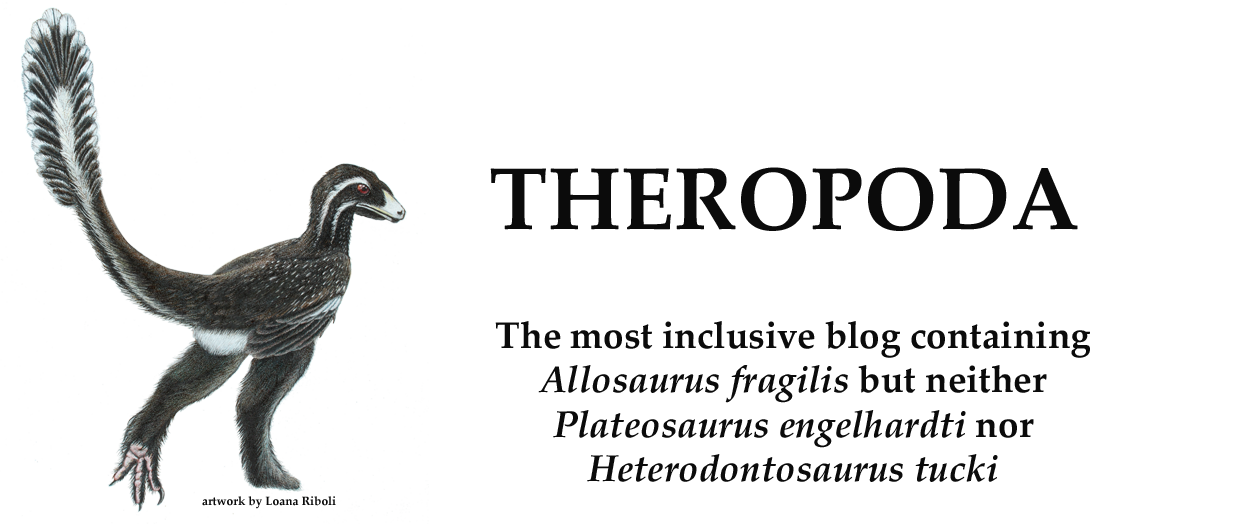Ho provato a ricostruire il cranio di
Irritator, per stimare di quanto il suo overbite incida nella
sporporzione tra rostro (premascellare + mascellare) e parte
anteriore della mandibola (dentale). Sebbene in Irritator il
dentale sia quasi completamente mancante, può essere stimato a
partire dalla parte rostrale (olotipo di Angaturama, che –
come sostenuto da molti – probabilmente proviene dal medesimo
esemplare dell'olotipo di Irritator).
Primo passo: la metà destra del
cranio di Irritator è quella con la minore deformazione. La
prendiamo come punto di partenza per la ricostruzione.
Secondo passo: la parte
posteriore della mandibola è invece meglio preservata nella metà
sinistra del cranio. Ribaltiamo questa parte e usiamola per
articolare la mandibola al cranio.
Terzo passo: aggiungiamo
l'olotipo di Angaturama, facendo combaciare la parte
posterodorsale del premascellare col frammento premascellare in
Irritator e la serie dei denti con quelli di Irritator.
Notare la quasi perfetta corrispondenza. La parte arancione nel
premascellare indica la cresta sagittale che continua la cresta
nasale di Irritator. Questa parte dona l'illusione che il
rostro di Angaturama sia molto spesso. La lunghezza totale del
cranio ottenuto risulta di circa 73 cm, quasi quanto la lunghezza del
cranio dell'olotipo di Baryonyx.
Quarto passo: completiamo le
parti mancanti e stimiamo le dimensioni del rostro (dalla sutura
jugale-mascellare all'apice del premascellare) e del dentale (dal
contatto col surangolare al punto in cui la rosetta dentale alloggia
sotto la rosetta premascellare). Il rosto è lungo quasi 50 cm, il
dentale poco più di 40 cm. Questo risultato indica che in Irritator
il rostro è lungo circa il 120% del dentale.
Quinto passo: Un risultato molto
interessante si ottiene se si completa la mandibola di Irritator
usando l'unico dentale di spinosaurino noto attualmente, quello
dell'olotipo di Spinosaurus: la corrispondenza nelle
proporzioni tra cranio e dentale è praticamente perfetta!
Questo risultato ci autorizza as usare
Irritator per stimare le dimensioni dei crani dell'olotipo di
Spinosaurus aegyptiacus e del cranio milanese. Siccome
in Irritator il cranio è 179% la lunghezza del dentale,
usando questo rapporto col dentale dell'olotipo di Spinosaurus
(lungo 75 cm) produce un cranio per l'olotipo di 134 cm. Siccome in
Irritator il cranio è 145% la lunghezza del rostro, usando
questo rapporto per il rostro milanese (lungo 99 cm) si ottiene un
cranio milanese di 144 cm. In base a queste stime, quindi,
l'esemplare milanese ha un cranio lungo circa il 107% dell'olotipo di
S. aegyptiacus. Tale valore di disparità tra i due
spinosaurini giganti rientra nel range di 105-110% che ho stimato in
precedenza con altri metodi.






Bellissimo post, davvero interessante. Scusa per la domanda un pò fuori luogo, ma quindi in Irritator/angaturama la cresta nasale si protendeva fino alla parte superiore del rostro? Scusa ancora per l'ignoranza, e grazie mille
RispondiEliminaMarco
Ma perché vi scusate per queste domande? (e poi ci sono quelli che invece fanno domande... idiote... e non si scusano). Sì, Angaturama (come Cristatusaurus) ha una cresta sagittale nel premascellare che è l'estensione anteriore della cresta nasale.
EliminaHi Andrea! You are the Spinosaurus specialist, yet I have this impression that the rostrum of Irritator/Angaturama is too short in your reconstruction of this spinosaurid. I also tried to reconstruct the skull of Irritator/Angaturama myself, based on the Spinosaurus snout from Milan. I got a skull with a much more elongated rostrum due to the fact that the premaxillary process of Spinosaurus is extremely long and the premaxillary body particularly antero-posteriorly elongated, which I would assume to be the case in Irritator/Angarturama as well. What do you think?
RispondiEliminaHi Cristophe,
RispondiEliminawell, I'm no more a Spinosaurus specialist than any other that studies theropods ;-)
My reconstructions assumes that there is not much missing part between the Irritator and the Angaturama pieces. The number of maxillary teeth in my reconstruction is 14-15 that I consider as a plausible number using the Milan specimen as a reference. Also, the Irritator specimen has a fragment of premaxillary subnarial ramus: this indicates that we have already most of the anterior ramus of maxilla preserved in the Irritator: otherwise, we must assume a very elongate subnarial ramus, that is the opposite of what we see in both the Milan specimen (where the process is completely reduced) and in baryonychines (where the process overlaps only the anterior third or less of the anterior ramus of maxilla). Thus, I'm confident my version is an accurate interpretation based on the other spinosaurids.
Furthermore, Irritator skull is about half the size of the Milan specimen, and I assume plausible that allometry produced more longirostrine skull in larger and more mature spinosaurids (and, thus, the Irritator skull is less longirostrine than larger spinosaurids).